The brand name resonates with today’s adults (30 and up), as if the sound of Jugoplastika evokes taxidermic images from the recent past. “Jugoplastika,” said a friend in a half-silent and pensive manner, almost speaking to himself, as he was processing the name and the images associated with it. “They used to make rubber boats, rubber boots, and … sandals. Those sandals!”
Immediately our conversation ended with everyone laughing while our headspace started filling up with generic images of the Adriatic coast during socialist Yugoslavia and swimmers sandaled with transparent Jugoplastika footwear, produced by a factory in Split (today’s Croatia) that ceased to exist more than 25 years ago. Recognizing our shared memory about the quintessential products evoked childhood memories but also a kind of ridicule. A ridicule that is shame-free since the long-forgotten aqua shoes were no longer in circulation and have already been forgotten by the younger generations.
Practical Jugoplastika rubber sandals are utterly unfashionable. Or should one use were? After Gucci launched black rubber sandals as a prêt-à-porter item in 2018, they became a thing. Newspapers from Slovenia, Croatia, and Serbia published this easily digestible “shocking” news. The articles were accompanied with photos of both pairs along with the scandalous price of almost €400 for a pair of Gucci sandals that are seemingly an exact copy of the Jugoplastika ones which, back in the day, could be bought dirt cheap. Without the golden Gucci buckle, of course.

Gucci, sandał gumowy ze sprzączką; źródło: www.gucci.com

Jugoplastika, sandały gumowe; egzemplarz kolekcjonerski; źródło: www.noizz.rs
However, the fashionistas’ choice of Gucci sandals would not be based on the same symbolic value that a Yugoslav-born member of the population would share. Symbolically, the “original” version of sandals represents the return of the repressed, albeit with a higher price tag. Everything, in post-transitional and post-socialist states, that feeds the ignorance of the West about socialist Yugoslavia has become symbolized in those yellowish sandals (despite the fact that Jugoplastika sandals were also available in other, more limited, colors): a state-funded tourism infrastructure, union-priced vacations at the Adriatic coast, organized leisure time, a lack of consumer choices.
We see an image of pimped out Gucci sandals, buckled with the letter “G” in gold, as a clue. Behind its opulent appearance their symbolic nature is apparent. For those that recognized the Jugoplastika design it was clear that the trademark design had not been protected. Was it even considered to be a designer product? Or was it merely a product like any other produced in Jugoplastika at the time, like rubber boats, plastic car equipment for Yugo cars, rain coats, sport equipment…?
The plasticity (yes, plastics again) of the images of sandals evokes thoughts of highly modernist images, namely A Pair of Boots painted by Vincent van Gogh and Diamond Dust Shoes by Andy Warhol in Fredric Jameson’s essay in The Cultural Logic of Late Capitalism. In one the readings of the painted footwear by Van Gogh and by Warhol, Jameson describes his reading of Diamond Dust Shoes in a way which “no longer speaks to us with any of the immediacy of Van Gogh’s footwear.” Jameson develops his philosophic reading through examples of Warhol’s work while developing one specific feature that he notes as differences between the modernist and post-modernist moment which comes up as a sign of “the waning of affect in the postmodern culture.”[1]
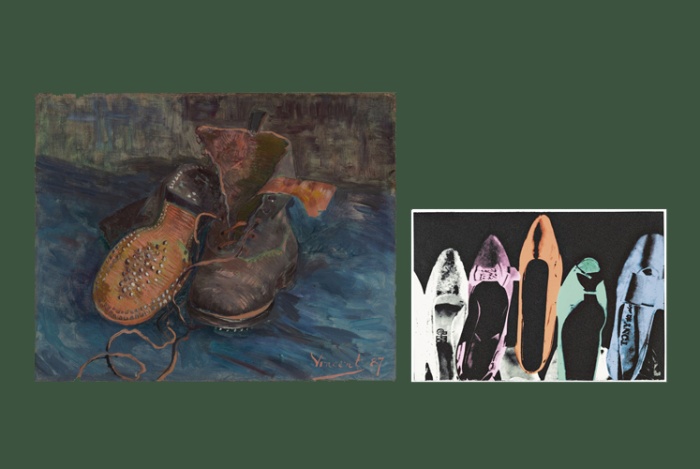
Z lewej: Vincent van Gogh, Para butów, 1887, Baltimore Museum of Art, źródło. Z prawej: Andy Warhol, Iskrzące się buty, 1980, źródło.
The disposition of the subject and more fundamental mutation of matters of content in the object world itself have, according to Jameson, become a set of texts or simulacra. As suggested in Jameson’s reading it is not to say that the postmodernist moment had lost all emotion or feeling or lost its subjectivity completely. For us, also in the example of product-based ad for sandals, it shows how the visual language of commodity entered the visual centrifuge without any pretext.
The pretext was invented by the media post ante in ex-Yugoslavia, so designer sandals in their eyes became a symbol of consumerist perversion.[2] Gucci sandals in the media were placed in juxtaposition with Jugoplastika sandals that suggests diametral readings of the two images: one highly commodified, autoreferential, and without any reference to the past, and the other as memory-evoking relict that ceased to exist as a product but claims to have been one for so many.
In this sense, Jugoplastika sandals are displayed as evidence material next to Gucci’s “incriminated” object. In this postmodern marinade of simulacra, the image of Jugoplastika sandals established itself through mediators as a materialization of the neoliberal oblivion that can function as a trigger for a reverse kind of symbolic decolonization, this time with a pun: “What you pay €400, we could buy for peanuts.” But would this reading of the meaning actually overcome the framework that actually does not allow us to see, yet alone imagine, that something else is at stake here? Evidence material is here to abolish the “originality” of the product but what was so original about Jugoplastika in the first place?
Yugoslavia, a state with a unique socialist model of worker self-management, had broken away from Stalin in 1948, establishing a form of market socialism. In reflections on Yugoslav socialism and writings about (post)transitional processes, the factory of Jugoplastika – as its name says, Yugoslav plastic – figures as a symbol of Yugoslav production, the so-called “rational consumption,” and flexibility, or should we say, plasticity of the Yugoslav “third way,” at the “crossroads between capitalism and socialism.” The new Yugoslav woman was a bearer of all these processes – as a producer, consumer, and consumed. It was mainly a “female factory,” as the majority of employees were women, in the managerial positions as well.
The factory opened in 1952, when ecological concern about the side effects of plastic was not so strong, and plastic had the “aroma of modernization.” According to Jurica Pavičić, the establishment of Jugoplastika fit into two strategic goals of the policy of the 1950s. As he elaborates, the documents explicitly state that Jugoplastika is founded in order to open up more jobs for women. At the same time, the founding of Jugoplastika fits into the then strategic goal of communist politics in the mid-1950s, which is economic growth through the strengthening of personal consumption.[3] A factory as the “center of social life” took care not just of employment, but also of leisure. As a part of this process, sports clubs connected to Jugoplastika were also born.
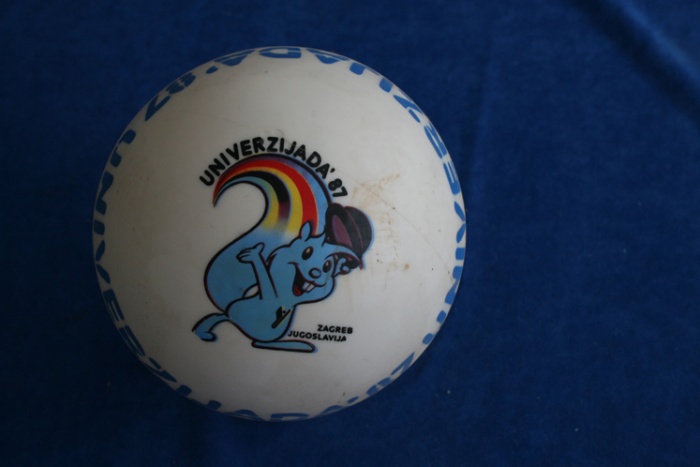
The Jugoplastika brand achieved the greatest glory in sport, more precisely in basketball. Thanks to basketball, the name Jugoplastika was so well known outside the borders of the former Yugoslavia that nowadays even a Spanish punk band is named after this “retired” brand. It’s hard not to remember the men’s basketball team starring Toni Kukoč and Dino Rađa. Between 1988 and 1991, this team won the European Championship three times in a row. The last time was in 1991, and it was not under the name of Jugoplastika. The club changed the name to Pop 84, after an Italian clothes company from Ancona, that was a sponsor of the club. In a way, it marked the beginning of the transition. And in the marriage of neoliberalism and nationalism, privatization was born. Jugoplastika factory, under the name Diokop, vanished a few years later.
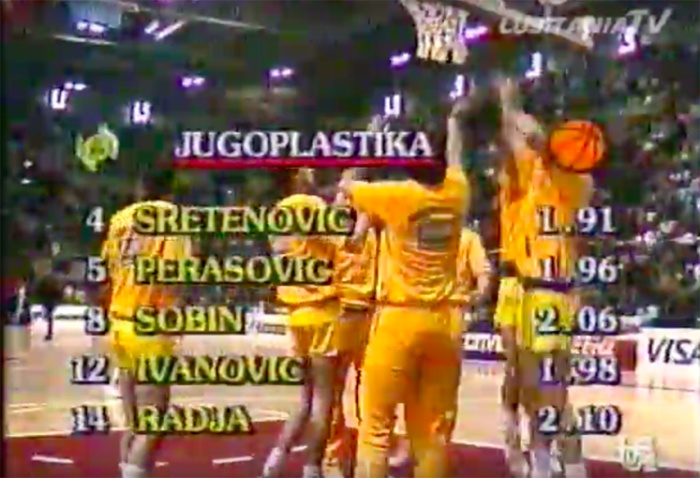
Klub sportowy Jugoplastika. Klatka z nagrania meczu piłki koszykowej, 1990; źródło.
And what about the workers themselves? A structure of feeling, a term by Raymond Willams that gender historian Chiara Bonfiglioli uses to describe the nexus of women’s emancipation, industrialization, and socialism, is useful here. It refers to the ways in which industrialization creates specific routines, expectations, and social memories in the everyday lives of workers. The feeling of communion and security that disappeared with the extinguishing of factories is a common (and initial) point of workers’ recollections. According to ethnologists Renata Jambrešić Kirin and Marina Blagaić Bergman, “If we could judge by the recollections of Jugoplastika’s former female workers, self-understanding of their emancipation and personal empowerment owes much more to regular wages and possibilities of crediting than to their (modest) participation in the political life or in the self-management of the factory.”[4]
According to the ethnographic resources, an experience of the Jugoplastika female worker is a typical story of a double burden of women as breadwinners and family caretakers in socialism, usually taken as an “obvious symptom of socialist contradictions.” In a way, a woman was supposed to be as flexible as plastic in juggling different duties, which resulted in the interplay between emancipation and passivization, but also feelings of pride and security, missing from the current neoliberal structure of feeling.
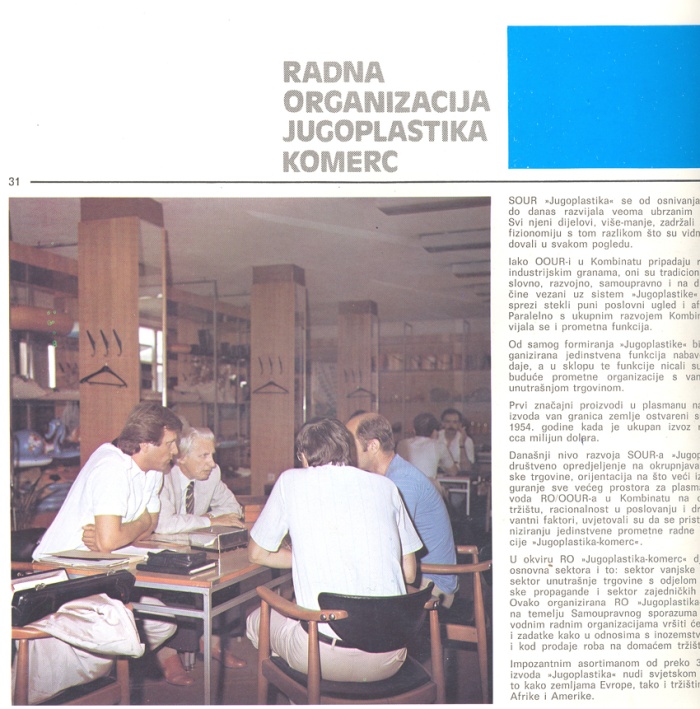
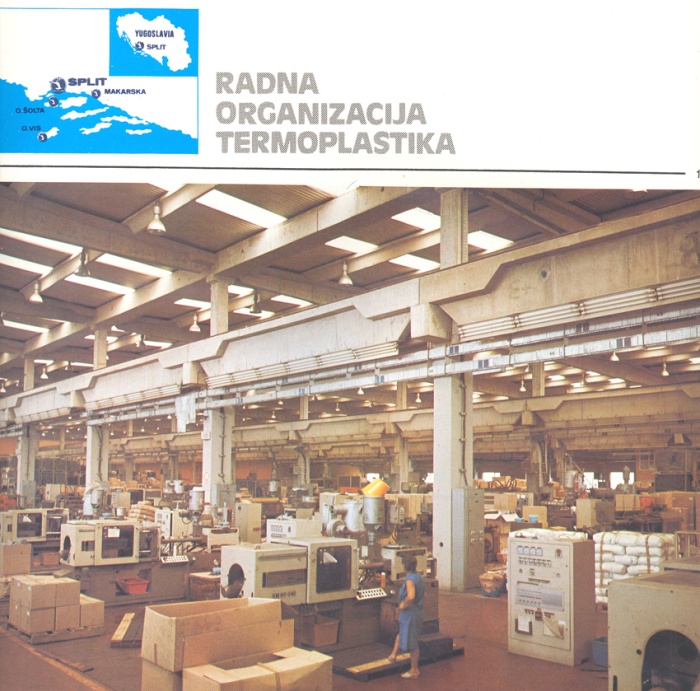
When it comes to widespread memories of Jugoplastika in ex-Yugoslavia, what is mostly remembered is not so much women’s emancipation via industrialization, but men’s success in sport, achieved when the factory was basically in decline. The men’s success in sport is better remembered than women’s economic emancipation and deprivation in industry, not necessarily because of a (strictly) gender asymmetry, but of the wider depoliticization of positive memories of socialism in ex-Yugoslavia. The other asymmetries are also at stake, as, according to many researchers, memories tend to revolve around everyday life and pleasures that workers experienced. They have priority over participation in political life, ascetic endeavor, or the building of socialism. Also, single triumphs, like winning the European championships, are, as milestones, easier to recall than the continuity of everyday life. According to Nina Vodopivec, quite often “workers themselves do not refer to socialism as a political era.”[5]

Pracownice Jugoplastiki; źródło: XXZ Magazin.
Nevertheless, there is a leftist mobilization of memories. Recalling everyday life and pleasures is not necessarily apolitical, Chiara Bonfiglioli claims that the “workers’ industrial structure of feeling developed during socialism – which was also profoundly gendered – lingers on in the post-socialist present and across the post-Yugoslav region, giving rise to demands for social justice and better welfare and labour conditions.” In that sense, Jugoplastika might be a frustrating reminder of what was lost in the transition, or of what has never been achieved in socialism, which does not mean we should not try to achieve it in the future. It is a reminder of both the economic emancipation and deprivation of women, a testament to the ambiguous process of their subjection and subjectivization.
If designer products are being produced in a way that even the original seems fake, why would we not support a mobilization of the forces against the conditions that make this possible? Those quirky plastic aqua shoes and their legacy are more original that what the bare image of them suggests. They have become an active, rather than a pacifying relict of the past. Not because they were Made in Yugoslavia but because Yugoslavia made them.
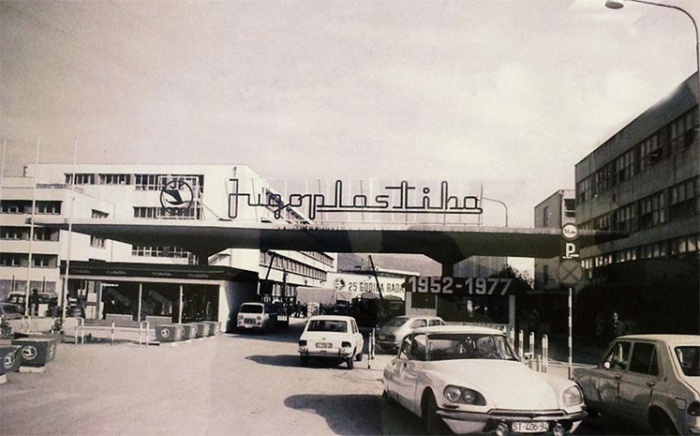
Fabryka Jugoplastika. Źródło: XXZ Magazin.
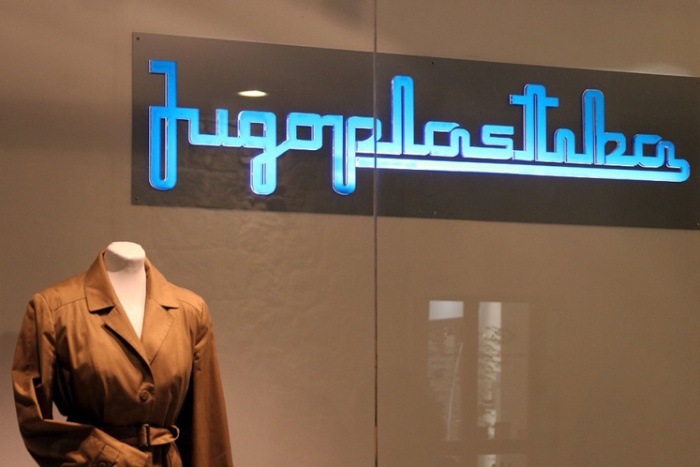
Sklep Jugoplastika. Źródło: tportal.hr.
BIO
Dare Pejić works as a publicist and a producer and holds a MSc in Sociology of Culture from the University of Ljubljana. He has collaborated with Ljubljana Digital Media Lab (Ljudmila) on the website project culture.si, an online cultural portal from Slovenia. As a freelance cultural worker, he has collaborated with many different organizations from Slovenia and abroad. Dare is a former member of the Theremidi Orchestra and currently lives between Ljubljana and Belgrade.
Marijana Mitrović completed her PhD in ethnology and anthropology at the University of Belgrade. She is in the process of obtaining her second PhD in sociology at the BGSS, Humboldt University in Berlin. She is the author of several papers published in peer-reviewed journals and a participant of several international academic conferences. Her main research interests are popular culture, gender, labor, and nationalism in Southeastern Europe.
*Cover photo: Jugoplastika rubber sandals; source: Noizz.rs.
[1] Jameson, Frederic (1991. Postmodernism or The Cultural Logic of Late Capitalism. Duke. UP, [accessed: http://xroads.virginia.edu/~DRBR/JAMESON/jameson.html
[2] http://www.sandzacke.rs/lifestyle/moda-i-ljepota/moda-nosile-su-se-u-bivsoj-jugoslaviji-a-gucci-ih-sada-prodaje-za-400-eura/
https://www.rtvslo.si/zabava/moda/sandale-nase-mladosti-gucci-prodaja-za-400-evrov/454455
https://mediasfera.rs/2018/05/09/guci-kao-jugoplastika-sandale-od-500-dolara-nosila-cela-sfrj/
https://www.24sata.hr/news/jugoplastika-ih-radila-davno-a-sad-su-postale-hit-zbog-guccija-572894
[3] Pavičić, Jurica. Slava Jugoplastici. XXZ. Online: https://www.xxzmagazin.com/slava-jugoplastici
[4] Jambrešić Kirin, Renata, and Marina Blagaić Bergman (2013). The Ambivalence of Socialist Working Women’s Heritage: A Case Study of the Jugoplastika Factory. Narodna Umjetnost 50 (1): 46.
[5] Vodopivec, Nina (2010). Past for the Present: The Social Memory of Textile Workers in Slovenia. In Remembering Socialism: Genres of Representation. Maria Todorova, ed. New York: 228.



